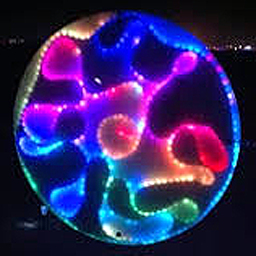#define LED_PIN 5
#define NUM_LEDS 50
#define BRIGHTNESS 64
#define LED_TYPE WS2811
#define COLOR_ORDER GRB
#define UPDATES_PER_SECOND 100
void ChangePalettePeriodically();
void FillLEDsFromPaletteColors(uint8_t colorIndex);
void SetupPurpleAndGreenPalette();
void SetupTotallyRandomPalette();
void SetupBlackAndWhiteStripedPalette();
void setup() {
delay( 3000 );
}
void loop()
{
ChangePalettePeriodically();
static uint8_t startIndex = 0;
startIndex = startIndex + 1;
FillLEDsFromPaletteColors( startIndex);
}
void FillLEDsFromPaletteColors( uint8_t colorIndex)
{
uint8_t brightness = 255;
for( int i = 0; i < NUM_LEDS; ++i) {
leds[i] =
ColorFromPalette( currentPalette, colorIndex, brightness, currentBlending);
colorIndex += 3;
}
}
void ChangePalettePeriodically()
{
uint8_t secondHand = (millis() / 1000) % 60;
static uint8_t lastSecond = 99;
if( lastSecond != secondHand) {
lastSecond = secondHand;
if( secondHand == 20) { SetupPurpleAndGreenPalette(); currentBlending =
LINEARBLEND; }
if( secondHand == 25) { SetupTotallyRandomPalette(); currentBlending =
LINEARBLEND; }
if( secondHand == 30) { SetupBlackAndWhiteStripedPalette(); currentBlending =
NOBLEND; }
if( secondHand == 35) { SetupBlackAndWhiteStripedPalette(); currentBlending =
LINEARBLEND; }
if( secondHand == 50) { currentPalette = myRedWhiteBluePalette_p; currentBlending =
NOBLEND; }
if( secondHand == 55) { currentPalette = myRedWhiteBluePalette_p; currentBlending =
LINEARBLEND; }
}
}
void SetupTotallyRandomPalette()
{
for( int i = 0; i < 16; ++i) {
}
}
void SetupBlackAndWhiteStripedPalette()
{
}
void SetupPurpleAndGreenPalette()
{
green, green, black, black,
purple, purple, black, black,
green, green, black, black,
purple, purple, black, black );
}
{
};
CFastLED FastLED
Global LED strip management instance.
central include file for FastLED, defines the CFastLED class/object
void delay(unsigned long ms)
Delay for the given number of milliseconds.
void setBrightness(uint8_t scale)
Set the global brightness scaling.
void show(uint8_t scale)
Update all our controllers with the current led colors, using the passed in brightness.
static CLEDController & addLeds(CLEDController *pLed, struct CRGB *data, int nLedsOrOffset, int nLedsIfOffset=0)
Add a CLEDController instance to the world.
RGB color palette with 16 discrete values.
#define TProgmemPalette16
Alias for TProgmemRGBPalette16.
#define FL_PROGMEM
PROGMEM keyword for storage.
@ TypicalLEDStrip
Typical values for SMD5050 LEDs.
void fill_solid(struct CRGB *targetArray, int numToFill, const struct CRGB &color)
Fill a range of LEDs with a solid color.
TBlendType
Color interpolation options for palette.
CRGB ColorFromPalette(const CRGBPalette16 &pal, uint8_t index, uint8_t brightness, TBlendType blendType)
Get a color from a palette.
@ NOBLEND
No interpolation between palette entries.
@ LINEARBLEND
Linear interpolation between palette entries, with wrap-around from end to the beginning again.
@ HUE_PURPLE
Purple (270°)
const TProgmemRGBPalette16 RainbowStripeColors_p
HSV Rainbow colors with alternatating stripes of black.
const TProgmemRGBPalette16 CloudColors_p
Cloudy color palette.
const TProgmemRGBPalette16 PartyColors_p
HSV color ramp: blue, purple, pink, red, orange, yellow (and back).
const TProgmemRGBPalette16 RainbowColors_p
HSV Rainbow.
LIB8STATIC uint8_t random8()
Generate an 8-bit random number.
Representation of an HSV pixel (hue, saturation, value (aka brightness)).
Representation of an RGB pixel (Red, Green, Blue)

